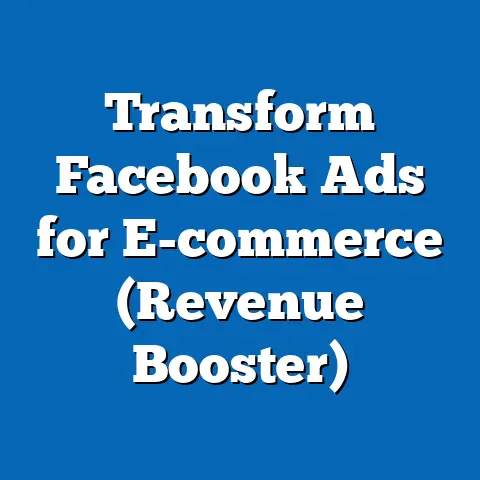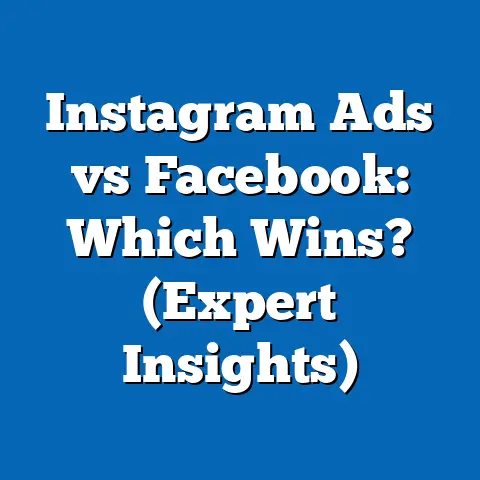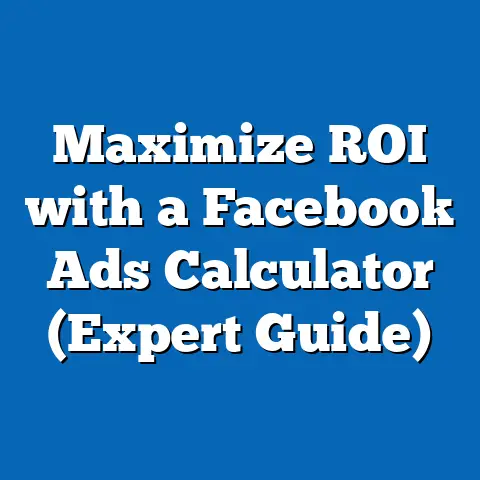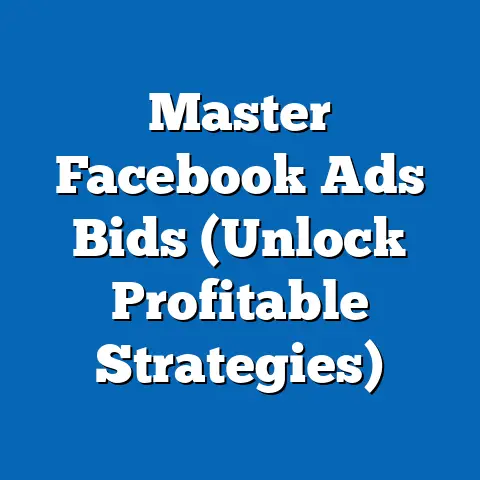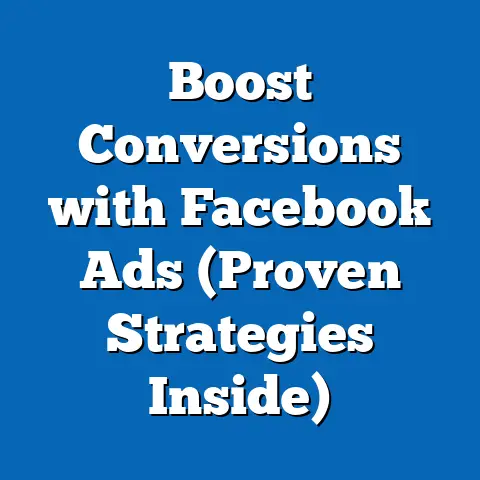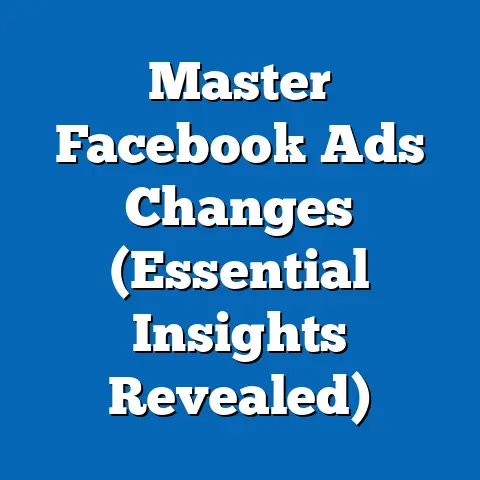Google vs Facebook Advertising: Winning Strategy (Expert Insights)
In the ever-evolving digital landscape, one thing remains constant: the dominance of Google and Facebook as advertising platforms. It’s remarkable how these two giants have not only survived but thrived, adapting to new technologies, user behaviors, and market trends. For businesses aiming to establish a strong online presence and maximize their advertising ROI, understanding the nuances of Google and Facebook advertising is not just beneficial – it’s essential.
I’ve spent years navigating the intricacies of both platforms, and I can tell you firsthand that there’s no one-size-fits-all answer to the “Google vs. Facebook” debate. It’s about understanding their strengths, weaknesses, and how they can work together to achieve your specific marketing goals. In this guide, I’ll break down everything you need to know to craft a winning advertising strategy using both Google and Facebook.
Overview of Google Advertising
Google Advertising, now known as Google Ads, has been a cornerstone of digital marketing since its inception. Its ability to connect businesses with potential customers actively searching for their products or services is unparalleled.
History and Evolution
Google Ads started as a simple text-based advertising platform, allowing businesses to bid on keywords to appear in search results. Over the years, it has evolved into a sophisticated ecosystem with diverse ad formats, advanced targeting options, and powerful analytics. The introduction of Quality Score, for example, completely changed the game, emphasizing relevance and user experience over simply having the highest bid.
The core of Google’s appeal lies in its focus on search intent. Users come to Google with a specific problem or need, and businesses can provide solutions in the form of targeted ads. This “pull” marketing approach is fundamentally different from Facebook’s “push” marketing, which I’ll discuss later.
Types of Google Ads
Google Ads offers a wide array of ad types to suit different marketing objectives:
- Search Ads: These are the classic text ads that appear at the top and bottom of Google’s search results pages. They’re ideal for capturing users who are actively searching for specific products or services.
- Display Ads: These are visually appealing ads that appear on websites across Google’s Display Network. They’re great for building brand awareness and reaching a wider audience.
- Video Ads: These ads run on YouTube and other video platforms, allowing businesses to engage with users through compelling video content. They’re perfect for storytelling and showcasing product demos.
- Shopping Ads: These ads showcase product images, prices, and store names directly in search results. They’re essential for e-commerce businesses looking to drive sales.
I’ve found that understanding the purpose of each ad type is crucial. For instance, if I’m launching a new product, I might use Display Ads to generate buzz and then use Search Ads to capture users who are actively searching for that product.
Targeting Capabilities
Google Ads offers robust targeting options to help businesses reach the right audience:
- Keyword Targeting: This allows you to target users based on the specific keywords they search for.
- Geographic Targeting: This enables you to target users based on their location, from country-level to local zip codes.
- Demographic Targeting: This allows you to target users based on their age, gender, income, and other demographic factors.
- Audience Targeting: This lets you target users based on their interests, behaviors, and life events.
A key factor in Google Ads is the Quality Score. This metric assesses the relevance and quality of your ads, keywords, and landing pages. A high Quality Score can lead to lower ad costs and better ad placement. I always emphasize optimizing Quality Score to my clients because it’s a direct path to a more efficient and effective campaign.
Performance Metrics
To gauge the success of your Google Ads campaigns, you need to track key performance metrics:
- CTR (Click-Through Rate): This measures the percentage of people who see your ad and click on it.
- CPC (Cost Per Click): This measures the average cost you pay for each click on your ad.
- Conversion Rate: This measures the percentage of people who click on your ad and complete a desired action, such as making a purchase or filling out a form.
- Cost Per Conversion: This measures the average cost you pay for each conversion.
I’ve learned that focusing solely on one metric can be misleading. For example, a high CTR is great, but it’s meaningless if it doesn’t translate into conversions. It’s essential to look at the entire funnel and optimize for the metrics that truly drive your business goals.
Takeaway: Google Ads is a powerful platform for reaching users with high search intent. Understanding the different ad types, targeting options, and performance metrics is crucial for creating effective campaigns. Always prioritize Quality Score to maximize your ROI.
Overview of Facebook Advertising
Facebook Advertising, now part of Meta Ads, has revolutionized the way businesses connect with potential customers. Its unparalleled targeting capabilities and diverse ad formats make it a formidable force in the digital advertising landscape.
History and Growth
Facebook Ads started as a simple way for businesses to promote their pages and products to Facebook users. Over time, it has evolved into a sophisticated platform with advanced targeting options, diverse ad formats, and powerful analytics. The introduction of the Facebook Pixel, for example, allowed businesses to track user behavior on their websites and optimize their campaigns based on real-world data.
Facebook’s strength lies in its ability to target users based on their interests, behaviors, and demographics. This “push” marketing approach allows businesses to reach users who may not be actively searching for their products or services but are likely to be interested in them.
I remember when Facebook Ads first started gaining traction. Many businesses were skeptical, viewing it as just a social media platform. However, the ability to target such specific audiences quickly proved its value, and Facebook Ads became an essential part of the marketing mix.
Types of Facebook Ads
Facebook Ads offers a variety of ad formats to suit different business goals:
- Image Ads: These are simple ads that feature a single image and text. They’re great for capturing attention and showcasing your brand.
- Video Ads: These ads feature video content and can be used to tell stories, demonstrate products, or provide valuable information.
- Carousel Ads: These ads allow you to showcase multiple images or videos in a single ad unit. They’re perfect for highlighting different products or features.
- Lead Ads: These ads allow you to collect leads directly on Facebook without sending users to your website. They’re ideal for generating leads for sales teams or building email lists.
I’ve found that the key to successful Facebook advertising is choosing the right ad format for your target audience and business goals. For example, if I’m running a contest, I might use a Lead Ad to collect entries directly on Facebook. If I’m showcasing a new product line, I might use a Carousel Ad to highlight the different items.
Targeting Capabilities
Facebook’s advanced targeting options are what truly set it apart:
- Interest Targeting: This allows you to target users based on their interests, hobbies, and passions.
- Behavioral Targeting: This enables you to target users based on their online and offline behaviors, such as purchase history, travel habits, and device usage.
- Demographic Targeting: This allows you to target users based on their age, gender, location, education, and other demographic factors.
- Lookalike Audiences: This allows you to create audiences that are similar to your existing customers or website visitors.
The ability to create Lookalike Audiences is particularly powerful. By uploading a list of your best customers, Facebook can identify users who share similar characteristics and behaviors, allowing you to reach a highly targeted and receptive audience.
Performance Metrics
To measure the success of your Facebook Ads campaigns, you need to track key performance metrics:
- Engagement Rate: This measures the percentage of people who interact with your ad, such as liking, commenting, or sharing it.
- Reach: This measures the number of unique people who saw your ad.
- Frequency: This measures the average number of times each person saw your ad.
- Conversion Rate: This measures the percentage of people who click on your ad and complete a desired action, such as making a purchase or filling out a form.
- Cost Per Result: This measures the average cost you pay for each desired result, such as a lead or a purchase.
I’ve learned that understanding the relationship between these metrics is crucial. For example, a high reach is great, but if the frequency is also high, it means you’re showing your ad to the same people repeatedly, which can lead to ad fatigue and decreased engagement.
Takeaway: Facebook Ads is a powerful platform for reaching highly targeted audiences. Understanding the different ad formats, targeting options, and performance metrics is crucial for creating effective campaigns. Leveraging Lookalike Audiences can significantly improve your results.
Comparing Google and Facebook Advertising
Now that we’ve explored Google and Facebook Advertising individually, let’s compare them side-by-side to understand their key differences and how they can complement each other.
Different Intent: Search vs. Social
The fundamental difference between Google and Facebook advertising lies in user intent. Google Ads targets users who are actively searching for specific products or services, while Facebook Ads targets users based on their interests, behaviors, and demographics.
- Google Ads: Focuses on search intent. Users come to Google with a specific need or problem, and businesses can provide solutions in the form of targeted ads.
- Facebook Ads: Focuses on social intent. Users are on Facebook to connect with friends, family, and communities. Businesses can reach users who may not be actively searching for their products or services but are likely to be interested in them.
I often explain it this way: Google is like fishing with a spear, targeting specific fish you know are there. Facebook is like fishing with a net, casting a wide net to catch a variety of fish that might be interested in your bait.
Cost Considerations
The costs associated with Google and Facebook advertising can vary depending on several factors, such as industry, target audience, and ad quality.
- Google Ads: Typically uses a Cost-Per-Click (CPC) bidding model, where you pay each time someone clicks on your ad. CPCs can range from a few cents to several dollars, depending on the competitiveness of the keywords you’re targeting.
- Facebook Ads: Can use either a CPC or a Cost-Per-Mille (CPM) bidding model, where you pay for every 1,000 impressions your ad receives. CPMs can range from a few dollars to several tens of dollars, depending on your target audience and ad quality.
I’ve found that Facebook Ads often have a lower CPC than Google Ads, but the conversion rates may also be lower. It’s essential to test different bidding strategies and monitor your performance to determine the most cost-effective approach for your business.
Ad Performance and ROI
The performance and ROI of Google and Facebook Ads can vary significantly depending on your business goals and target audience.
- Google Ads: Tends to perform well for businesses that are targeting users with high purchase intent, such as e-commerce businesses or businesses offering services that solve a specific problem. The ROI can be high if you’re able to target the right keywords and optimize your landing pages for conversions.
- Facebook Ads: Tends to perform well for businesses that are building brand awareness, generating leads, or driving traffic to their website. The ROI can be high if you’re able to target the right audience and create engaging ad creative.
I always advise my clients to track their ROI for both platforms separately to understand which one is delivering the best results. It’s also important to consider the long-term value of customers acquired through each platform.
Integration and Synergy
The most effective advertising strategies often involve integrating Google and Facebook Ads for a cohesive marketing approach.
- Retargeting: You can use Google Ads to retarget users who have visited your website from Facebook Ads, and vice versa. This allows you to stay top-of-mind with potential customers and increase your chances of conversion.
- Lookalike Audiences: You can use data from your Google Ads campaigns to create Lookalike Audiences on Facebook, and vice versa. This allows you to expand your reach and target new customers who are likely to be interested in your products or services.
- Multi-Channel Campaigns: You can create campaigns that utilize both Google and Facebook Ads to achieve different marketing objectives. For example, you might use Google Ads to drive immediate sales and Facebook Ads to build brand awareness and generate leads.
I’ve seen firsthand how integrating Google and Facebook Ads can significantly improve overall marketing performance. By leveraging the strengths of both platforms, you can create a more comprehensive and effective advertising strategy.
Takeaway: Google and Facebook Ads serve different purposes and target different audiences. Understanding these differences is crucial for creating a winning advertising strategy. Integrating both platforms can lead to a more comprehensive and effective marketing approach.
Expert Insights and Recommendations
To further enhance your understanding of Google and Facebook advertising, let’s delve into some expert insights and recommendations.
Insights from Industry Experts
I’ve had the opportunity to learn from some of the best minds in the digital marketing industry, and here are a few key insights they’ve shared:
- “Google Ads is still the king of search intent, but Facebook Ads is catching up with its advanced targeting capabilities.” – Neil Patel, Digital Marketing Expert
- “Don’t underestimate the power of retargeting. It’s one of the most effective ways to convert website visitors into customers.” – Larry Kim, Founder of WordStream
- “Always test different ad creative and targeting options to find what works best for your business.” – Amy Porterfield, Online Marketing Expert
These insights highlight the importance of staying up-to-date with the latest trends and best practices in digital advertising. It’s also crucial to continuously test and optimize your campaigns to maximize your ROI.
Choosing the Right Platform for Your Business
Determining which platform is better suited for your business depends on your unique needs and goals. Here are a few factors to consider:
- Target Audience: Where does your target audience spend most of their time online? If they’re actively searching for your products or services on Google, then Google Ads may be the better choice. If they’re spending time on social media platforms like Facebook, then Facebook Ads may be more effective.
- Business Goals: What are you trying to achieve with your advertising campaigns? If you’re trying to drive immediate sales, then Google Ads may be the better choice. If you’re trying to build brand awareness or generate leads, then Facebook Ads may be more effective.
- Budget: How much are you willing to spend on advertising? Google Ads can be more expensive than Facebook Ads, especially for competitive keywords.
I always recommend starting with a small budget and testing both platforms to see which one delivers the best results. It’s also important to track your ROI for each platform separately to understand which one is delivering the most value.
Future of Advertising on Google and Facebook
The future of advertising on Google and Facebook is likely to be shaped by several key trends:
- Artificial Intelligence (AI): AI is already playing a significant role in both Google and Facebook advertising, and its influence is only going to grow in the future. AI can be used to automate tasks, optimize campaigns, and personalize ad experiences.
- Privacy Concerns: As privacy concerns continue to grow, both Google and Facebook are likely to face increasing pressure to protect user data. This may lead to changes in targeting options and ad formats.
- Evolving Consumer Behavior: Consumer behavior is constantly evolving, and businesses need to stay up-to-date with the latest trends to remain competitive. This may involve experimenting with new ad formats, targeting options, and messaging strategies.
I believe that businesses that are able to adapt to these changes will be the ones that succeed in the long run. It’s essential to stay informed, experiment with new technologies, and continuously optimize your campaigns to maximize your ROI.
Takeaway: Expert insights and recommendations can help you make informed decisions about your advertising strategy. Consider your target audience, business goals, and budget when choosing the right platform for your business. Stay up-to-date with the latest trends and best practices to remain competitive.
Conclusion: Crafting a Winning Strategy
In conclusion, both Google and Facebook advertising have their unique advantages, and the best strategy often involves a combination of both platforms tailored to the specific goals of the business.
Google Ads is ideal for reaching users with high search intent, while Facebook Ads is perfect for targeting specific audiences based on their interests, behaviors, and demographics. Integrating both platforms can lead to a more comprehensive and effective marketing approach.
To craft a winning strategy, you need to:
- Understand your target audience: Where do they spend most of their time online? What are their needs and interests?
- Define your business goals: What are you trying to achieve with your advertising campaigns? Are you trying to drive immediate sales, build brand awareness, or generate leads?
- Set a budget: How much are you willing to spend on advertising?
- Test different platforms and strategies: Experiment with different ad formats, targeting options, and bidding strategies to find what works best for your business.
- Track your results: Monitor your performance metrics and track your ROI for each platform separately to understand which one is delivering the most value.
- Continuously optimize your campaigns: Stay up-to-date with the latest trends and best practices, and continuously optimize your campaigns to maximize your ROI.
The digital advertising landscape is constantly evolving, and businesses need to be adaptable and willing to experiment to stay ahead of the curve. By following these guidelines and continuously monitoring your campaigns, you can craft a winning advertising strategy that delivers long-term success.
I hope this guide has provided you with valuable insights and actionable recommendations for crafting a winning advertising strategy using both Google and Facebook. Remember, there’s no one-size-fits-all answer, but by understanding the strengths and weaknesses of each platform and tailoring your approach to your specific needs, you can achieve your marketing goals and drive sustainable growth for your business.

